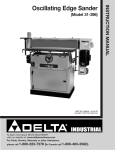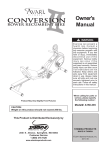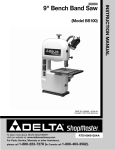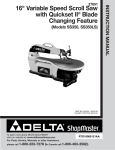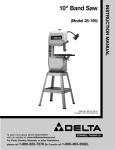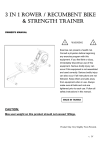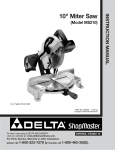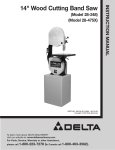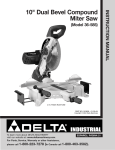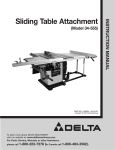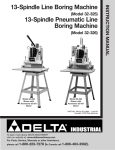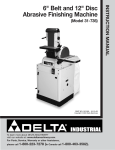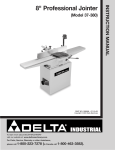Download Delta BS220LS Instruction manual
Transcript
(Model BS220LS) PART NO. 909507 - 12-23-02 Copyright © 2002 Delta Machinery To learn more about DELTA MACHINERY visit our website at: www.deltamachinery.com. ESPAÑOL: PÁGINA 21 For Parts, Service, Warranty or other Assistance, please call 1-800-223-7278 (In Canada call 1-800-463-3582). INSTRUCTION MANUAL 12" Band Saw SAFETY GUIDELINES / DEFINITIONS This manual contains information that is important for you to know and understand. This information relates to protecting YOUR SAFETY and PREVENTING EQUIPMENT PROBLEMS. To help you recognize this information, we use the symbols to the right. Please read the manual and pay attention to these sections. Indicates an imminently hazardous situation which, if not avoided, will result in death or serious injury. Indicates a potentially hazardous situation which, if not avoided, could result in death or serious injury. Indicates a potentially hazardous situation which, if not avoided, may result in minor or moderate injury Used without the safety alert symbol indicates potentially hazardous situation which, if not avoided, may result in property damage. SOME DUST CREATED BY POWER SANDING, SAWING, GRINDING, DRILLING, AND OTHER CONSTRUCTION ACTIVITIES contains chemicals known to cause cancer, birth defects or other reproductive harm. Some examples of these chemicals are: · lead from lead-based paints, · crystalline silica from bricks and cement and other masonry products, and · arsenic and chromium from chemically-treated lumber. Your risk from these exposures varies, depending on how often you do this type of work. To reduce your exposure to these chemicals: work in a well ventilated area, and work with approved safety equipment, such as those dust masks that are specially designed to filter out microscopic particles. GENERAL SAFETY RULES Woodworking can be dangerous if safe and proper operating procedures are not followed. As with all machinery, there are certain hazards involved with the operation of the product. Using the machine with respect and caution will considerably lessen the possibility of personal injury. However, if normal safety precautions are overlooked or ignored, personal injury to the operator may result. Safety equipment such as guards, push sticks, hold-downs, featherboards, goggles, dust masks and hearing protection can reduce your potential for injury. But even the best guard won’t make up for poor judgment, carelessness or inattention. Always use common sense and exercise caution in the workshop. If a procedure feels dangerous, don’t try it. Figure out an alternative procedure that feels safer. REMEMBER: Your personal safety is your responsibility. This machine was designed for certain applications only. Delta Machinery strongly recommends that this machine not be modified and/or used for any application other than that for which it was designed. If you have any questions relative to a particular application, DO NOT use the machine until you have first contacted Delta to determine if it can or should be performed on the product. Technical Service Manager Delta Machinery 4825 Highway 45 North Jackson, TN 38305 (IN CANADA: 505 SOUTHGATE DRIVE, GUELPH, ONTARIO N1H 6M7) Read Operator’s Manual. Do not operate equipment until you have read Operator’s Manual for Safety, Assembly, Operation, and Maintenance Instructions. FAILURE TO FOLLOW THESE RULES MAY RESULT IN SERIOUS PERSONAL INJURY 1. FOR YOUR OWN SAFETY, READ INSTRUCTION MANUAL BEFORE OPERATING THE TOOL. Learn the tool’s application and limitations as well as the specific hazards peculiar to it. 2. KEEP GUARDS IN PLACE and in working order. 3. ALWAYS WEAR EYE PROTECTION. Wear safety glasses. Everyday eyeglasses only have impact resistant lenses; they are not safety glasses. Also use face or dust mask if cutting operation is dusty. These safety glasses must conform to ANSI Z87.1 requirements. NOTE: Approved glasses have Z87 printed or stamped on them. 4. REMOVE ADJUSTING KEYS AND WRENCHES. Form habit of checking to see that keys and adjusting wrenches are removed from tool before turning it “on”. 5. KEEP WORK AREA CLEAN. Cluttered areas and benches invite accidents. 6. DON’T USE IN DANGEROUS ENVIRONMENT. Don’t use power tools in damp or wet locations, or expose them to rain. Keep work area well-lighted. 7. KEEP CHILDREN AND VISITORS AWAY. All children and visitors should be kept a safe distance from work area. 8. MAKE WORKSHOP CHILDPROOF – with padlocks, master switches, or by removing starter keys. 9. DON’T FORCE TOOL. It will do the job better and be safer at the rate for which it was designed. 10. USE RIGHT TOOL. Don’t force tool or attachment to do a job for which it was not designed. 11. WEAR PROPER APPAREL. No loose clothing, gloves, neckties, rings, bracelets, or other jewelry to get caught in moving parts. Nonslip footwear is recommended. Wear protective hair covering to contain long hair. 12. SECURE WORK. Use clamps or a vise to hold work when practical. It’s safer than using your hand and frees both hands to operate tool. 13. DON’T OVERREACH. Keep proper footing and balance at all times. 14. MAINTAIN TOOLS IN TOP CONDITION. Keep tools sharp and clean for best and safest performance. Follow instructions for lubricating and changing accessories. 15. DISCONNECT TOOLS before servicing and when changing accessories such as blades, bits, cutters, etc. 16. USE RECOMMENDED ACCESSORIES. The use of accessories and attachments not recommended by Delta may cause hazards or risk of injury to persons. 2 17. REDUCE THE RISK OF UNINTENTIONAL STARTING. Make sure switch is in “OFF” position before plugging in power cord. In the event of a power failure, move switch to the “OFF” position. 18. NEVER STAND ON TOOL. Serious injury could occur if the tool is tipped or if the cutting tool is accidentally contacted. 19. CHECK DAMAGED PARTS. Before further use of the tool, a guard or other part that is damaged should be carefully checked to ensure that it will operate properly and perform its intended function – check for alignment of moving parts, binding of moving parts, breakage of parts, mounting, and any other conditions that may affect its operation. A guard or other part that is damaged should be properly repaired or replaced. 20. DIRECTION OF FEED. Feed work into a blade or cutter against the direction of rotation of the blade or cutter only. 21. NEVER LEAVE TOOL RUNNING UNATTENDED. TURN POWER OFF. Don’t leave tool until it comes to a complete stop. 22. STAY ALERT, WATCH WHAT YOU ARE DOING, AND USE COMMON SENSE WHEN OPERATING A POWER TOOL. DO NOT USE TOOL WHILE TIRED OR UNDER THE INFLUENCE OF DRUGS, ALCOHOL, OR MEDICATION. A moment of inattention while operating power tools may result in serious personal injury. 23. MAKE SURE TOOL IS DISCONNECTED FROM P O W E R S U P P LY w h i l e m o t o r i s b e i n g m o u n t e d , connected or reconnected. 24. THE DUST GENERATED by certain woods and wood products can be injurious to your health. Always operate machinery in well ventilated areas and provide for proper dust removal. Use wood dust collection systems whenever possible. ADDITIONAL SAFETY RULES FOR BAND SAWS FAILURE TO FOLLOW THESE RULES MAY RESULT IN SERIOUS PERSONAL INJURY. 1. 2. 3. 4. 5. 6. 7. 8. 9. 10. 11. 12. 13. 14. NEVER REACH UNDER THE TABLE while the machine is running. 15. TURN THE MACHINE “OFF” to back out of an uncompleted or jammed cut. 16. MAKE “RELIEF” CUTS prior to cutting long curves. 17. TURN THE MACHINE “OFF” and wait for the blade to stop prior to cleaning the blade area, removing debris near the blade, removing or securing workpiece, or changing the angle of the table. A coasting blade can be dangerous. 18. NEVER PERFORM LAYOUT, ASSEMBLY, or setup work on the table/work area when the machine is running. 19. TURN THE MACHINE “OFF” AND DISCONNECT THE MACHINE from the power source before installing or removing accessories, before adjusting or changing set-ups, or when making repairs. 20. TURN THE MACHINE “OFF”, disconnect the machine from the power source, and clean the table/work area before leaving the machine. LOCK THE SWITCH IN THE “OFF” POSITION to prevent unauthorized use. 21. ADDITIONAL INFORMATION regarding the safe and proper operation of this tool is available from the Power Tool Institute, 1300 Summer Avenue, Cleveland, OH 44115-2851. Information is also available from the National Safety Council, 1121 Spring Lake Drive, Itasca, IL 60143-3201. Please refer to the American National Standards Institute ANSI 01.1 Safety Requirements for Woodworking Machines and the U.S. Department of Labor OSHA 1910.213 Regulations. DO NOT OPERATE THIS MACHINE UNTIL it is assembled and installed according to the instructions. OBTAIN ADVICE from your supervisor, instructor, or another qualified person if you are not familiar with the operation of this tool. FOLLOW ALL WIRING CODES and recommended electrical connections. USE THE GUARDS WHENEVER POSSIBLE. Check to see that they are in place, secured, and working correctly. USE PROPER BLADE SIZE and type. ADJUST THE UPPER BLADE GUIDE so that it is about 1/8" above the workpiece. PROPERLY ADJUST the blade tension, tracking, blade guides, and blade support bearings. KEEP ARMS, HANDS, AND FINGERS away from the blade. AVOID AWKWARD OPERATIONS and hand positions where a sudden slip could cause a hand to move into the blade. NEVER START THE MACHINE before clearing the table of all objects (tools, scrap pieces, etc.). NEVER START THE MACHINE with the workpiece against the blade. HOLD WORKPIECE FIRMLY against the table. DO NOT attempt to saw a workpiece that does not have a flat surface against the table. HOLD WORKPIECE FIRMLY and feed into blade at a moderate speed. SAVE THESE INSTRUCTIONS. Refer to them often and use them to instruct others. 3 POWER CONNECTIONS A separate electrical circuit should be used for your machines. This circuit should not be less than #12 wire and should be protected with a 20 Amp time lag fuse. If an extension cord is used, use only 3-wire extension cords which have 3prong grounding type plugs and matching receptacle which will accept the machine’s plug. Before connecting the machine to the power line, make sure the switch (s) is in the “OFF” position and be sure that the electric current is of the same characteristics as indicated on the machine. All line connections should make good contact. Running on low voltage will damage the machine. DO NOT EXPOSE THE MACHINE TO RAIN OR OPERATE THE MACHINE IN DAMP LOCATIONS. MOTOR SPECIFICATIONS Your machine is wired for 120 volt, 60 HZ alternating current. Before connecting the machine to the power source, make sure the switch is in the “OFF” position. GROUNDING INSTRUCTIONS THIS MACHINE MUST BE GROUNDED WHILE IN USE TO PROTECT THE OPERATOR FROM ELECTRIC SHOCK. 1. All grounded, cord-connected machines: 2. Grounded, cord-connected machines intended for use on a supply circuit having a nominal rating less than 150 volts: In the event of a malfunction or breakdown, grounding provides a path of least resistance for electric current to reduce the risk of electric shock. This machine is equipped with an electric cord having an equipmentgrounding conductor and a grounding plug. The plug must be plugged into a matching outlet that is properly installed and grounded in accordance with all local codes and ordinances. If the machine is intended for use on a circuit that has an outlet that looks like the one illustrated in Fig. A, the machine will have a grounding plug that looks like the plug illustrated in Fig. A. A temporary adapter, which looks like the adapter illustrated in Fig. B, may be used to connect this plug to a matching 2-conductor receptacle as shown in Fig. B if a properly grounded outlet is not available. The temporary adapter should be used only until a properly grounded outlet can be installed by a qualified electrician. The green-colored rigid ear, lug, and the like, extending from the adapter must be connected to a permanent ground such as a properly grounded outlet box. Whenever the adapter is used, it must be held in place with a metal screw. Do not modify the plug provided - if it will not fit the outlet, have the proper outlet installed by a qualified electrician. Improper connection of the equipment-grounding conductor can result in risk of electric shock. The conductor with insulation having an outer surface that is green with or without yellow stripes is the equipmentgrounding conductor. If repair or replacement of the electric cord or plug is necessary, do not connect the equipment-grounding conductor to a live terminal. NOTE: In Canada, the use of a temporary adapter is not permitted by the Canadian Electric Code. Check with a qualified electrician or service personnel if t h e g ro u n d i n g i n s t r u c t i o n s a re n o t c o m p l e t e l y understood, or if in doubt as to whether the machine is properly grounded. IN ALL CASES, MAKE CERTAIN THE R E C E P TA C L E I N Q U E S T I O N I S P R O P E R LY G R O U N D E D . I F Y O U A R E N O T S U R E H AV E A QUALIFIED ELECTRICIAN CHECK THE RECEPTACLE. Use only 3-wire extension cords that have 3-prong grounding type plugs and matching 3-conductor receptacles that accept the machine’s plug, as shown in Fig. A. Repair or replace damaged or worn cord immediately. GROUNDED OUTLET BOX GROUNDED OUTLET BOX GROUNDING MEANS CURRENT CARRYING PRONGS ADAPTER GROUNDING BLADE IS LONGEST OF THE 3 BLADES Fig. A 4 Fig. B EXTENSION CORDS Use proper extension cords. Make sure your extension cord is in good condition and is a 3-wire extension cord which has a 3-prong grounding type plug and matching receptacle which will accept the machine’s plug. When using an extension cord, be sure to use one heavy enough to carry the current of the machine. An undersized cord will cause a drop in line voltage, resulting in loss of power and overheating. Fig. D, shows the correct gauge to use depending on the cord length. If in doubt, use the next heavier gauge. The smaller the gauge number, the heavier the cord. MINIMUM GAUGE EXTENSION CORD RECOMMENDED SIZES FOR USE WITH STATIONARY ELECTRIC MACHINES Ampere Rating Volts Total Length of Cord in Feet Gauge of Extension Cord 0-6 0-6 0-6 0-6 120 120 120 120 up to 25 25-50 50-100 100-150 18 AWG 16 AWG 16 AWG 14 AWG 6-10 6-10 6-10 6-10 120 120 120 120 up to 25 25-50 50-100 100-150 18 AWG 16 AWG 14 AWG 12 AWG 10-12 10-12 10-12 10-12 120 120 120 120 up to 25 25-50 50-100 100-150 16 AWG 16 AWG 14 AWG 12 AWG 12-16 12-16 12-16 120 120 120 up to 25 25-50 14 AWG 12 AWG GREATER THAN 50 FEET NOT RECOMMENDED Fig. D OPERATING INSTRUCTIONS FOREWORD The Delta ShopMaster Model BS220LS 12" Band Saw has a powerful 1/2 HP, induction motor for smooth performance and long life. The BS220LS is supplied with a sturdy steel stand which provides heavy-duty support and a comfortable work height. UNPACKING AND CLEANING Carefully unpack the machine and all loose items from the shipping container(s). Remove the protective coating from all unpainted surfaces. This coating may be removed with a soft cloth moistened with kerosene (do not use acetone, gasoline or lacquer thinner for this purpose). After cleaning, cover the unpainted surfaces with a good quality household floor paste wax. NOTICE: THE MANUAL COVER PHOTO ILLUSTRATES THE CURRENT PRODUCTION MODEL. ALL OTHER ILLUSTRATIONS ARE REPRESENTATIVE ONLY AND MAY NOT DEPICT THE ACTUAL COLOR, LABELING OR ACCESSORIES AND MAY BE INTENDED TO ILLUSTRATE TECHNIQUE ONLY. 5 BAND SAW PARTS 1 12 16 13 17 14 18 15 2 3 6 4 10 5 11 7 8 9 Fig. 2 1. 2. 3. 4. 5. 6. 7. 8. 9. 10. 11. 12. 13. 14. 15. 16. 17. 18. Band Saw 12¾" Upper Brace (2) 21½" Upper Brace (2) 17" Lower Brace (2) 25¾" Lower Brace (2) 26¼" Leg (4) Blade Guide Assembly Blade Guide Assembly Lock Knob Blade Guide Assembly Lock Plate 6 Table Assembly Plastic Foot (4) M8x1.25x70mm Hex Socket Head Screw (1) M8x1.25x45mm Hex Head Screw (4) M8x1.25x20mm Hex Socket Head Screw (2) M8x1.25x16mm Carriage Head Screw (32) 3/8" Flat Washer (32) M8.4 Flat Washer (9) M8x1.25 Hex Nut (34) ASSEMBLY FOR YOUR OWN SAFETY, DO NOT CONNECT THE MACHINE TO THE POWER SOURCE UNTIL THE MACHINE IS COMPLETELY ASSEMBLED AND YOU READ AND UNDERSTAND THE ENTIRE INSTRUCTION MANUAL. STAND 1. Assemble stand as shown in Fig. 3, using parts shown in Fig. 2. The braces, legs and feet are numbered the same in both illustrations. Insert the M8x1.25x16mm carriage head screws through legs and braces then place the 3/8" flat washers on the screws and secure with the M8x1.25 hex nuts. Only tighten nuts finger-tight at this time. NOTE: The top lips of the side braces (2) Fig. 3, must fit on top of the front and rear braces (3). The top lips of the side braces (4) Fig. 3, must fit on top of the front and rear braces (5). 2 3 6 4 5 11 Fig. 3 2. Attach the four plastic feet (11) Fig. 3, to the bottom of each leg (6). BAND SAW TO STAND 1. Fig. 4 illustrates the two through holes (A) and two threaded holes (C) which will be used to secure the band saw to the stand. A C Fig. 4 2. Place the band saw on top of stand and line up the two threaded holes (C) Fig. 4, with the two holes (D) Fig. 5, on upper brace of stand. D D Fig. 5 7 3. Place a M8.4 flat washer onto a M8x1.25x45mm hex head screw. Insert the screw through the hole (D) Fig. 6, in the stand and thread screw into the tapped hole in the band saw and tighten securely. Repeat this process for the remaining hole in stand and threaded hole in the band saw and tighten securely. D 4. Align the remaining two holes (A) Fig. 4, with the two holes in the stand. Place a M8.4 flat washer (H) Fig. 7, on a M8x1.25x45mm hex head screw. Insert screw (F) through the hole in band saw and the hole in the stand. Place a M8.4 flat washer onto screw (F) Fig. 7, and thread a M8x1.25 hex nut onto screw (F) and tighten securely. Fig. 6 H F 5. Place a M8.4 flat washer onto a M8x1.25x45mm hex head screw. Insert screw (G) Fig. 7, through the hole in stand and the hole in the band saw. Place a M8.4 flat washer onto screw (G) Fig. 7, and thread a M8x1.25 hex nut onto screw (G) and tighten securely. 6. Push down on the top of the band saw, and make sure that all four stand feet are contacting the supporting surface. Tighten all stand hardware at this time. G Fig. 7 TABLE A 1. Remove the M6x1x30mm cheese head screw (A), M6.4 flat washer (B), and M6x1wing nut (C) Fig. 8, from slotted end (D). Slide table (E) into position on the band saw as shown in Fig. 8. C B D E Fig. 8 2. Align the three holes in the table bracket (F) Fig. 9, with the three holes in the side of the band saw. Place a M8.4 flat washer onto a M8x1.25x70mm. Insert the screw through the hole (G) Fig. 9, in the table bracket and thread the screw into the hole in the band saw, and tighten securely. G 3. Place a M8.4 flat washer onto a M8x1.25x20mm. Insert the screw through the hole (H) Fig. 9, in the table bracket and thread the screw into the hole in the band saw, and tighten securely. Repeat this process for the remaining hole (H) Fig. 9. F H H Fig. 9 8 4. Place a M6.4 flat washer (B) Fig. 10, onto a M6x1x30mm cheese head screw (A), and insert screw slot in table. Thread a M6x1 wing nut (C) Fig. 10, onto the screw and tighten securely. A B C Fig. 10 UPPER BLADE GUIDE ASSEMBLY C B Fasten the upper blade guide assembly (A) Fig. 11, to the side of the band saw using the lock plate (B) and lock screw (C) as shown. A Fig. 11 OPERATING CONTROLS AND ADJUSTMENTS STARTING AND STOPPING SAW The switch (A) Fig. 13, is located on the front side of the band saw. To turn the saw “ON” move the switch (A) up to the “ON” position. To turn the saw “OFF” move the switch (A) down to the “OFF” position. A Fig. 13 LOCKING SWITCH IN THE “OFF” POSITION IMPORTANT: When the tool is not in use, the switch should be locked in the “OFF” position to prevent unauthorized use. This can be done by grasping the switch toggle (B) Fig. 14, and pulling it out of the switch, as shown. With the switch toggle (B) removed, the switch will not operate. However, should the switch toggle be removed while the machine is running, the switch can be turned “OFF” once, but cannot be restarted without inserting the switch toggle (B). B Fig. 14 9 OPENING AND CLOSING HINGED DOOR A C When making adjustments such as changing the blade, tracking the blade, blade guide adjustments, etc., the hinged doors (A) and (B) Figs. 15 and 16, can be opened as follows: B NEVER OPEN THE HINGED DOOR WHEN THE MACHINE IS RUNNING. D 1. Pull out on the two door knobs (C) and (D) Fig. 15, and swing doors (A) and (B) open. Fig. 15 2. Fig. 16, illustrates doors (A) and (B) in the open position. 3. To close and fasten doors (A) and (B), Figs. 15 and 16, press on door directly over door knobs (C) and (D) Fig. 15, until latches snap into the locking position. A B Fig. 16 ADJUSTING BLADE TENSION With the saw blade centered on the two band saw wheels, slightly loosen wing nut located behind knob (D) Fig. 17. Turn the tension knob (A) Fig. 17, clockwise to increase blade tension or counter-clockwise to decrease blade tension until the indicator (B) lines up with the corresponding blade width on scale (C). Tighten wing nut located behind knob (D). NOTE: The scale is correct for average work, and is not affected by use of re-brazed saw blades. We urge you to use the scale until you have become familiar enough with the operation of the band saw to vary the tension a little for different kinds of blades or work. Over-tensioning is a common cause of blade breakage and unsatisfactory blade performance. When the band saw is not in use, it is good practice to release tension to prolong the life of the blade. A C B D Fig. 17 10 TRACKING THE BLADE A For accurate work and maximum blade life, it is important that the blade (A) Fig. 18, be centered on the upper band saw wheel. When this adjustment is properly made, the blade will “track” – that is, it will run steady in the same line. To “track” the blade, proceed as follows: B DISCONNECT MACHINE FROM POWER SOURCE. Fig. 18 1. Make sure the blade is tensioned properly. Make sure the blade guides and blade support bearings are clear of the blade so as not to interfere with the tracking adjustment. 2. Rotate the upper wheel (B) Fig. 18, slowly by hand to determine if the blade is riding on the center of the wheel. 3. If the blade is not riding on the center of the wheel, loosen wing nut (C) Fig. 19, and while turning the upper wheel by hand, turn tracking adjusting knob (D) slightly clockwise or counterclockwise. You will notice that the saw blade will move to the right or left on the wheel. D C NEVER RUN THE SAW TO TRACK THE BLADE. Fig. 19 4. When the blade is tracking properly, tighten wing nut (C) Fig. 19. 5. Close the wheel cover after the adjustment is made. ADJUSTING UPPER BLADE GUIDE ASSEMBLY The upper blade guide assembly (A) Fig. 20, should always be set about 1/8" above or as close as possible to the top surface of the workpiece being cut. Loosen lock screw (B) and position the guide assembly to the desired height and tighten lock screw (B). B A Fig. 20 11 ADJUSTING UPPER BLADE GUIDES AND BLADE SUPPORT BEARING A J The blade guides must be properly adjusted to prevent the blade from twisting during operation. The upper blade guides and blade support bearing should be adjusted only after the blade is tensioned and tracking properly. To adjust, proceed as follows: G H G DISCONNECT MACHINE FROM POWER SOURCE. Fig. 21 1. Loosen screw (A) Fig. 21, and remove blade guard (B) from guide assembly. 2. The upper guide bracket (C) Fig. 22, is assembled to the lower end of the guide post (D) by screw (E). Loosen screw (E) and move the guide bracket (C) in or out until the front edge of the guides (F) are just behind the blade “gullets” (bottom of saw teeth) while making sure the guides are flat with the blade then tighten screw (E). D 3. The upper blade guides are held in the guide bracket with set screws (G) Fig. 21. Loosen set screws (G) and adjust blade guides as close as possible to the sides of the saw blade being careful not to pinch the saw blade. Then tighten screws (G). E 4. The upper blade support bearing (H) Fig. 21, prevents the blade from being pushed back too far while cutting which could damage the set in the saw teeth. The upper support bearing (H) should be adjusted approximately 1/64" behind the blade by loosening set screw (J), moving the support bearing in or out until it is 1/64" behind the back of the blade and tightening set screw (J). C F Fig. 22 5. MAKE CERTAIN TO REPLACE BLADE GUARD THAT WAS REMOVED IN STEP 1. ADJUSTING LOWER BLADE GUIDES AND BLADE SUPPORT BEARING The lower blade guides and blade support bearing should be adjusted at the same time as the upper guides and bearing as follows: DISCONNECT MACHINE FROM POWER SOURCE. A 1. Loosen screw (A) Fig. 23, and move the guide bracket (B) in or out until the front edge of the guides (C) are just behind the blade “gullets” (bottom of saw teeth) while making sure the guides are flat with the blade then tighten screw (A). C B Fig. 23 12 B 2. The lower blade guides are held in the guide bracket with set screws (D) Fig. 24. Loosen set screws (D) and adjust blade guides as close as possible to the sides of the saw blade, being careful not to pinch the saw blade. Then tighten set screws (D). D 3. The lower blade support bearing (E) Fig. 24, prevents the blade from being pushed back too far while cutting which could damage the set in the saw teeth. The lower support bearing (E) should be adjusted approximately 1/64" behind the blade by loosening set screw (F) and moving the support bearing in or out. When adjusted, tighten set screw (F). D F E Fig. 24 TILTING THE TABLE The table can be tilted 45 degrees to the right and approximately 3 degrees to the left. To tilt the table, loosen lock handle (A) Fig. 25, tilt the table to the desired angle and tighten lock handle (A). NOTE: The table lock handle (A) can be repositioned by pulling out on the handle and repositioning it on the nut located underneath the hub of the handle. A scale (B) and pointer (C) is provided to indicate the degree of table tilt. C B A Fig. 25 ADJUSTING TABLE POSITIVE STOP D A positive stop is provided to insure that the table is returned 90 degrees to the blade after tilting. Place a square (D) Fig. 26, on the table and against the blade and check to see if the table is 90 degrees to the blade as shown. If an adjustment is necessary, loosen lock nut (E) and turn screw (F) with wrench (G) until table surface is 90 degrees to blade, and screw (F) is contacting the frame. Then tighten locknut (E). G E F Fig. 26 BAND SAW MINIMUM CUTTING RADIUS Turning radius may vary depending on the type of blade and amount of set. Each blade, however, depending on its width, can cut continuously without back tracking any curve having a radius as much or more than the specified minimum turning radius of the blade, as shown in the chart (A) Fig. 27, located inside top wheel cover. A Always use the widest blade possible and limit use of narrow blades for sawing small, abrupt curves and for fine delicate work. Fig. 27 13 MAINTENANCE ADJUSTING BELT TENSION B If the drive belt on your band saw is slipping, check and adjust as follows: DISCONNECT MACHINE FROM POWER SOURCE. A 1. Remove screw (A) Fig. 29, and belt and pulley cover (B). 2. A poly V-belt (C) Fig. 30, drives the saw pulley (D) from the motor pulley (E). Correct tension of the belt (C) is when there is approximately 1/4" deflection in the center span of the belt (C) using light finger pressure. If belt tension needs to be adjusted, loosen motor mounting hardware and slide motor forward or backward until correct tension is obtained. Then tighten motor mounting hardware. Fig. 29 E WHEEL BRUSHES D Two wheel brushes (A) and (B) Fig. 31, are provided to keep the blade and tires clean and free of any build-up of chips. Brush (A) cleans the tire and brush (B) cleans the blade. Adjustment of the brushes can be made by loosening the mounting hardware and adjusting the brushes accordingly. C Fig. 30 CHANGING BLADES To change blades, proceed as follows: DISCONNECT MACHINE FROM POWER SOURCE. A 1. Pull handles (C) and (D) Fig. 15, and open doors (A) and (B) as shown in Fig. 32. B 2. Loosen screw (C) Fig. 32, and remove blade guard (D). 3. Release tension on the band saw blade by turning knob (E) Fig. 32, counterclockwise. Fig. 31 4. Remove table alignment screw (F) Fig. 32 and table insert. E 5. Slip the blade off both wheels and guide it out through the slot in the table. A 6. Check new blade to be sure teeth will point down towards table when installed. IF NOT, TURN BLADE INSIDE OUT. D C 7. Place new blade on wheels and adjust tension, guides and tracking as previously described. 8. Replace blade guard that was removed in STEP 2. F B 9. Close doors (A) and (B) Fig. 32, before operating. 10. Replace table insert and alignment screw (F) Fig. 32, that was removed in STEP 4. Fig. 32 14 DUST CHUTE A dust chute (A) Fig. 33, is provided which enables you to connect your band saw to a standard shop vacuum or dust collector. The opening of the dust chute is 2-1/4" I.D. A Fig. 33 OPERATING THE BAND SAW Before starting the machine, insure that all adjustments are properly made and the guards are in place. Turn the upper wheel by hand to make sure that everything is correct BEFORE turning on the power. Keep the top guide within 1/8" of the work piece at all times. Do not force the material against the blade. Light pressure on the work piece will produce a smoother cut, and prevent excess friction, and heating of the blade. KEEP THE SAW BLADE SHARP. Very little forward pressure is required for normal cutting. Keep the workpiece moving at a slow and consistent rate against the blade to ensure a smooth and accurate cut. Avoid twisting the blade by trying not to turn sharp corners. Remember, you must saw around corners. CUTTING CURVES When cutting curves, turn the stock carefully so that the blade follows without twisting. If a curve is so abrupt that it is necessary to repeatedly back up and cut a new kerf, a narrower blade, a blade with more set, or additional relief cuts Fig. 34, may be necessary to allow the blade to cut more efficiently. The more set a blade has, the easier it will allow the stock to be turned, but the cut is usually rougher. When withdrawing the piece being cut, changing the cut, or for any other reason, be careful not to accidentally draw the blade off the wheels. In most cases, it is easier and safer to turn the stock and saw out through the waste material, rather than try to withdraw the stock from the blade. Fig. 34 15 TROUBLESHOOTING GUIDE In spite of how well a band saw is maintained, problems can occur. The following troubleshooting guide will help you solve the more common problems: Trouble: SAW WILL NOT START. Probable Cause Remedy 1. Saw not plugged in. 1. Plug in saw. 2. Fuse blown or circuit breaker tripped. 2. Replace fuse or reset circuit breaker. 3. Cord damaged. 3. Have cord replaced. Trouble: BREAKER KICKS OUT FREQUENTLY. Probable Cause Remedy 1. Improper extension cord. 1. Replace with adequate size cord. (see chart) 2. Feeding stock too fast. 2. Feed stock more slowly. 3. Blade in poor condition (dull, warped, gummed). 3. Clean or replace blade. 4. Low voltage supply. 4. Contact an electrician. Trouble: BAND SAW VIBRATES EXCESSIVELY. Probable Cause Remedy 1. Machine not mounted securely to stand. 1. Tighten all mounting hardware. 2. Stand on uneven surface. 2. Reposition on flat level surface. 3. Worn belt. 3. Replace belt. 4. Belt not tensioned correctly. 4. Adjust belt tension. 5. Motor not fastened securely. 5. Tighten all mounting hardware. Trouble: BAND SAW DOES NOT COME UP TO SPEED. Probable Cause Remedy 1. Low voltage due to improper extension cord size. 1. Replace with adequate size cord. (see chart) 2. Low voltage. 2. Contact an electrician. Trouble: BLADES BREAK. Probable Cause Remedy 1. Blade not tensioned properly. 1. Adjust blade tension. 2. Blade guides improperly adjusted. 2. Check and adjust blade guides. 3. Blade support bearing improperly adjusted. 3. Adjust blade support bearing. 4. Blade wheel tracking adjustment improperly set. 4. Check and adjust blade tracking. 5. Bad weld on blade. 5. Replace the blade. 6. Worn tires. 6. Replace tires. 7. Forcing wide blade around short radius. 7. Change to a narrower blade. 8. Dull blade or insufficient set. 8. Replace blade. 9. Upper blade guide set too high. 9. Set upper blade guide within 1/8" of workpiece. 10. Continuous running of machine when not actually cutting. 10. Turn off machine when not performing cutting operation. (continued on next page) 16 TROUBLESHOOTING GUIDE (CONTINUED) Trouble: BLADE WILL NOT TRACK. Probable Cause Remedy 1. Blade too loose 1. Adjust tension 2. Upper wheel not properly adjusted. 2. Adjust upper wheel. 3. Improperly adjusted blade support bearing. 3. Adjust blade support bearing. Trouble: CUT DOES NOT AGREE WITH SETTING ON THE TILT SCALE. Probable Cause Remedy 1. Pointer out of adjustment 1. Adjust pointer. Trouble: BLADE WILL NOT STAY ON WHEEL. Probable Cause Remedy 1. Blade not tensioned properly. 1. Adjust blade tension. 2. Blade guides improperly adjusted. 2. Check and adjust blade guides. 3. Blade support bearing improperly adjusted. 3. Adjust blade support bearing. 4. Blade wheel not tracking properly. 4. Check and adjust blade tracking. 5. Bad weld on blade. 5. Replace the blade. 6. Worn tires. 6. Replace tires. Trouble: BAND SAW MAKES UNSATISFACTORY CUTS. Probable Cause Remedy 1. Blade not tensioned properly. 1. Adjust blade tension. 2. Blade guides improperly adjusted. 2. Check and adjust blade guides. 3. Blade support bearing improperly set. 3. Adjust blade support bearing. 4. Blade wheel not tracking properly. 4. Check and adjust blade tracking. 5. Bad weld on blade. 5. Replace the blade. 6. Worn tires. 6. Replace tires. 7. Incorrect blade for work being done. 7. Change the blade. 8. Dull blade or insufficient set. 8. Replace blade. 9. Upper blade guide set too high. 9. Set upper blade guide within 1/8" of work piece. 17 BAND SAW BLADES A band saw blade is a delicate piece of steel that is subjected to tremendous strain. You can obtain long use from a band saw blade if you use it properly. Be sure you use blades of the proper thickness, width and temper for the various types of material and cuts. Always use the widest blade possible. Use narrow blades only for sawing small, abrupt curves and for fine, delicate work. This will save blades and will produce better cuts. For cutting wood and similar materials, Delta offers blades in widths of 1/8", 3/16", 1/4", 3/8", and 1/2". Any one of a number of conditions may cause a band saw blade to break. Blade breakage is, in some cases, unavoidable, being the natural result of the peculiar stresses to which blades are subjected. Blades will break often due to avoidable causes, such as the lack of care to the blade or the blade not being properly adjusted to the band saw. The most common causes of blade breakage are: (1) faulty alignments and adjustments of the guides. (2) forcing or twisting a wide blade around a curve of short radius. (3) feeding the work piece too fast into the blade. (4) dullness of the teeth, or absence of sufficient set. (5) improperly tensioned blade. (6) top guide set too high above the work piece being cut. (7) using a blade with a lumpy or improperly finished braze or weld. (8) continuous running of the saw blade when not cutting. Use blades that are 82" in length on this machine. Always use a sharp blade. Keep it free from gum and pitch. Clean frequently with a stiff fiber brush. Narrow blades are used for cutting small circles or curves while the wider blades are best suited for straight cutting such as ripping. A new blade, in most cases, will perform better and last longer than a re-sharpened blade. Insure that the blade guides are adjusted properly. Do not force or twist the blade around a curve or a very short radius. Feed the workpiece through the blade at a consistent rate, allow the blade to do the cutting – do not feed the work piece too fast. Do not apply excessive tension to the blade. The tension is only necessary to drive the blade without slipping on the wheels. Narrow blades require less tension than wider blades. 18 NOTES 19 ACCESSORIES A complete line of accessories is available from your Delta Supplier, Porter-Cable • Delta Factory Service Centers, and Delta Authorized Service Stations. Please visit our Web Site www.deltamachinery.com for a catalog or for the name of your nearest supplier. Since accessories other than those offered by Delta have not been tested with this product, use of such accessories could be hazardous. For safest operation, only Delta recommended accessories should be used with this product. PARTS, SERVICE OR WARRANTY ASSISTANCE All Delta Machines and accessories are manufactured to high quality standards and are serviced by a network of Porter-Cable • Delta Factory Service Centers and Delta Authorized Service Stations. To obtain additional information regarding your Delta quality product or to obtain parts, service, warranty assistance, or the location of the nearest service outlet, please call 1-800-223-7278 (In Canada call 1-800-463-3582). Two Year Limited Warranty Delta will repair or replace, at its expense and at its option, any Delta machine, machine part, or machine accessory which in normal use has proven to be defective in workmanship or material, provided that the customer returns the product prepaid to a Delta factory service center or authorized service station with proof of purchase of the product within two years and provides Delta with reasonable opportunity to verify the alleged defect by inspection. Delta may require that electric motors be returned prepaid to a motor manufacturer’s authorized station for inspection and repair or replacement. Delta will not be responsible for any asserted defect which has resulted from normal wear, misuse, abuse or repair or alteration made or specifically authorized by anyone other than an authorized Delta service facility or representative. Under no circumstances will Delta be liable for incidental or consequential damages resulting from defective products. This warranty is Delta’s sole warranty and sets forth the customer’s exclusive remedy, with respect to defective products; all other warranties, express or implied, whether of merchantability, fitness for purpose, or otherwise, are expressly disclaimed by Delta. Printed in U.S.A. 20 PORTER-CABLE • DELTA SERVICE CENTERS (CENTROS DE SERVICIO DE PORTER-CABLE • DELTA) Parts and Repair Service for Porter-Cable • Delta Machinery are Available at These Locations (Obtenga Refaccion de Partes o Servicio para su Herramienta en los Siguientes Centros de Porter-Cable • Delta) ARIZONA Tempe 85282 (Phoenix) 2400 West Southern Avenue Suite 105 Phone: (602) 437-1200 Fax: (602) 437-2200 CALIFORNIA Ontario 91761 (Los Angeles) 3949A East Guasti Road Phone: (909) 390-5555 Fax: (909) 390-5554 San Leandro 94577 (Oakland) 3039 Teagarden Street Phone: (510) 357-9762 Fax: (510) 357-7939 COLORADO Arvada 80003 (Denver) 8175 Sheridan Blvd., Unit S Phone: (303) 487-1809 Fax: (303) 487-1868 FLORIDA Davie 33314 (Miami) 4343 South State Rd. 7 (441) Unit #107 Phone: (954) 321-6635 Fax: (954) 321-6638 Tampa 33609 4538 W. Kennedy Boulevard Phone: (813) 877-9585 Fax: (813) 289-7948 GEORGIA Forest Park 30297 (Atlanta) 5442 Frontage Road, Suite 112 Phone: (404) 608-0006 Fax: (404) 608-1123 ILLINOIS Addison 60101 (Chicago) 400 South Rohlwing Rd. Phone: (630) 424-8805 Fax: (630) 424-8895 Woodridge 60517 (Chicago) 2033 West 75th Street Phone: (630) 910-9200 Fax: (630) 910-0360 MARYLAND Elkridge 21075 (Baltimore) 7397-102 Washington Blvd. Phone: (410) 799-9394 Fax: (410) 799-9398 MASSACHUSETTS Braintree 02185 (Boston) 719 Granite Street Phone: (781) 848-9810 Fax: (781) 848-6759 Franklin 02038 (Boston) Franklin Industrial Park 101E Constitution Blvd. Phone: (508) 520-8802 Fax: (508) 528-8089 MICHIGAN Madison Heights 48071 (Detroit) 30475 Stephenson Highway Phone: (248) 597-5000 Fax: (248) 597-5004 MINNESOTA Minneapolis 55429 5522 Lakeland Avenue North Phone: (763) 561-9080 Fax: (763) 561-0653 Cleveland 44125 8001 Sweet Valley Drive Unit #19 Phone: (216) 447-9030 Fax: (216) 447-3097 MISSOURI North Kansas City 64116 1141 Swift Avenue Phone: (816) 221-2070 Fax: (816) 221-2897 OREGON Portland 97230 4916 NE 122 nd Ave. Phone: (503) 252-0107 Fax: (503) 252-2123 St. Louis 63119 7574 Watson Road Phone: (314) 968-8950 Fax: (314) 968-2790 NEW YORK Flushing 11365-1595 (N.Y.C.) 175-25 Horace Harding Expwy. Phone: (718) 225-2040 Fax: (718) 423-9619 NORTH CAROLINA Charlotte 28270 9129 Monroe Road, Suite 115 Phone: (704) 841-1176 Fax: (704) 708-4625 OHIO Columbus 43214 4560 Indianola Avenue Phone: (614) 263-0929 Fax: (614) 263-1238 PENNSYLVANIA Willow Grove 19090 520 North York Road Phone: (215) 658-1430 Fax: (215) 658-1433 TEXAS Carrollton 75006 (Dallas) 1300 Interstate 35 N, Suite 112 Phone: (972) 446-2996 Fax: (972) 446-8157 Houston 77055 West 10 Business Center 1008 Wirt Road, Suite 120 Phone: (713) 682-0334 Fax: (713) 682-4867 WASHINGTON Auburn 98001(Seattle) 3320 West Valley HWY, North Building D, Suite 111 Phone: (253) 333-8353 Fax: (253) 333-9613 Authorized Service Stations are located in many large cities. Telephone 800-438-2486 or 731-541-6042 for assistance locating one. Parts and accessories for Porter-Cable·Delta products should be obtained by contacting any Porter-Cable·Delta Distributor, Authorized Service Center, or Porter-Cable·Delta Factory Service Center. If you do not have access to any of these, call 800-223-7278 and you will be directed to the nearest Porter-Cable·Delta Factory Service Center. Las Estaciones de Servicio Autorizadas están ubicadas en muchas grandes ciudades. Llame al 800-438-2486 ó al 731-541-6042 para obtener asistencia a fin de localizar una. Las piezas y los accesorios para los productos Porter-Cable·Delta deben obtenerse poniéndose en contacto con cualquier distribuidor Porter-Cable·Delta, Centro de Servicio Autorizado o Centro de Servicio de Fábrica Porter-Cable·Delta. Si no tiene acceso a ninguna de estas opciones, llame al 800-223-7278 y le dirigirán al Centro de Servicio de Fábrica Porter-Cable·Delta más cercano. CANADIAN PORTER-CABLE • DELTA SERVICE CENTERS ALBERTA Bay 6, 2520-23rd St. N.E. Calgary, Alberta T2E 8L2 Phone: (403) 735-6166 Fax: (403) 735-6144 BRITISH COLUMBIA 8520 Baxter Place Burnaby, B.C. V5A 4T8 Phone: (604) 420-0102 Fax: (604) 420-3522 MANITOBA 1699 Dublin Avenue Winnipeg, Manitoba R3H 0H2 Phone: (204) 633-9259 Fax: (204) 632-1976 ONTARIO 505 Southgate Drive Guelph, Ontario N1H 6M7 Phone: (519) 836-2840 Fax: (519) 767-4131 QUÉBEC 1515 ave. St-Jean Baptiste, Québec, Québec G2E 5E2 Phone: (418) 877-7112 Fax: (418) 877-7123 1447, Begin St-Laurent, (Montréal), Québec H4R 1V8 Phone: (514) 336-8772 Fax: (514) 336-3505 The following are trademarks of PORTER-CABLE·DELTA (Las siguientes son marcas registradas de PORTER-CABLE S.A.): Auto-Set®, BAMMER®, B.O.S.S.®, Builder’s Saw®, Contractor’s Saw®, Contractor’s Saw II™, Delta®, DELTACRAFT®, DELTAGRAM™, Delta Series 2000™, DURATRONIC™, Emc²™, FLEX ®, Flying Chips™, FRAME SAW ®, Homecraft ®, INNOVATION THAT WORKS ®, Jet-Lock ®, JETSTREAM®, ‘kickstand®, LASERLOC®, MICRO-SET®, Micro-Set®, MIDI LATHE®, MORTEN™, NETWORK™, OMNIJIG®, POCKET CUTTER®, PORTA-BAND®, PORTA-PLANE®, PORTER-CABLE®&(design), PORTER-CABLE®PROFESSIONAL POWER TOOLS, Posi-Matic®, Q-3®&(design), QUICKSAND®&(design), QUICKSET™, QUICKSET II®, QUICKSET PLUS™, RIPTIDE™&(design), SAFE GUARD II®, SAFELOC®, Sanding Center®, SANDTRAP®&(design), SAW BOSS®, Sawbuck™, Sidekick®, SPEED-BLOC®, SPEEDMATIC®, SPEEDTRONIC®, STAIR EASE®, The American Woodshop®&(design), The Lumber Company®&(design), THE PROFESSIONAL EDGE®, THE PROFESSIONAL SELECT ®, THIN-LINE™, TIGER ®, TIGER CUB ®, TIGER SAW ®, TORQBUSTER ®, TORQ-BUSTER ®, TRU-MATCH™, TWIN-LITE ®, UNIGUARD®, Unifence®, UNIFEEDER™, Unihead®, Uniplane™, Unirip®, Unisaw®, Univise®, Versa-Feeder®, VERSA-PLANE® , WHISPER SERIES®, WOODWORKER’S CHOICE™. Trademarks noted with ™ and ® are registered in the United States Patent and Trademark Office and may also be registered in other countries. Las Marcas Registradas con el signo de ™ y ® son registradas por la Oficina de Registros y Patentes de los Estados Unidos y también pueden estar registradas en otros países. Printed in U.S.A.





















